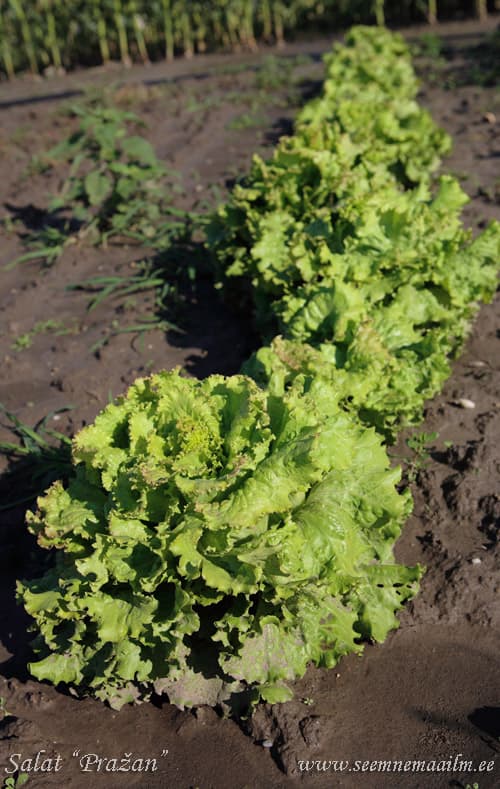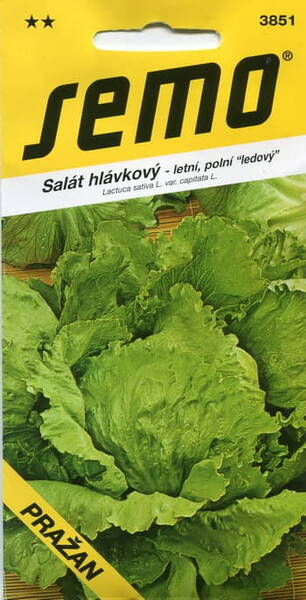Ex Tax: 1.14€
This is a type of iceberg summer lettuce, suitable for direct sowing. The head is extremely large, round-shaped, well closed and compact. This variety is resistant to saliency to flower.
Weight per 1000 seeds = 1,0-1,2 g.
The number of seeds in 1,0 g = 830-1000.
Agriculture.
The best predecessors for lettuce are cabbage and potatoes, under which organic fertilizers were applied. In autumn, plowing or digging is carried out with the introduction of humus.
Acidic soils require liming. Mineral fertilizers are applied in spring. Seeds are sown in open ground in early April, in wide rows with row spacing of 60-70 cm. The sowing depth is 1.5-2 cm.
Rolling is carried out before and after sowing. When dense shoots appear, thinning is performed twice: in the phase of one true leaf at a distance of 5-7 cm and 1.5 months after sowing, leaving a distance of 15-20 cm between plants. After thinning, fertilizing is carried out with a solution of a special complex fertilizer.
Care consists in loosening row spacing and watering. Watering is carried out along the furrows, trying to avoid getting water on the leaves of plants.
Lettuce harvesting is carried out by cutting off the rosette of leaves at the very surface of the soil.

* Lettuce is profitable to grow from early spring to late autumn. It is not affected by diseases that other vegetable crops suffer from. The lettuce does not harm the neighbours that grow next to it. Lettuce is a good precursor to almost any vegetable. The exception is a few representatives of the Asteraceae family. In the place where he grew up, you can plant any vegetable plant, there will be no harm to him. In short, lettuce is indispensable in crop rotations.
No wonder he's so popular. The body's resistance to carcinogens is directly related to the regular consumption of lettuce. Today, every pregnant woman already knows that she needs to eat lettuce almost every day for the normal development of her child. Of course, it is necessary to ensure that the salad does not contain excessive amounts of nitrates.
It is extremely useful for a person: it contains carotene, ascorbic and folic acid, B vitamins and a huge amount of valuable trace elements. It is prescribed for anaemia because, in terms of the content of iron and vitamins, lettuce surpasses almost all other green crops. In addition, lettuce contains a lot of iodine in compounds that are perfectly absorbed by the human body. The chlorophyll contained in lettuce is very similar in structure to blood haemoglobin, it stimulates the formation of red blood cells and haemoglobin itself. Lettuce relieves increased nervousness, so characteristic of residents of big cities helps with insomnia and relieves us of disturbing dreams. We have listed far from all the medicinal properties of lettuce.
What is a salad, if not a real miracle vegetable?
Plus, it's just delicious. In winter, lettuce is much easier to grow than many other vegetables. Leaves suitable for human consumption grow back within 30-40 days after emergence. However, it does not require high temperatures to develop. Lettuce seeds begin to germinate already at +4°C. The optimal temperature for the germination of lettuce seeds and their growth is considered to be + 14 + 16 ° С.
You can grow lettuce all year round and almost anywhere - in greenhouses, in pots on the windowsill, and, of course, in open ground from mid-April to the end of August.
Eng.: Lettuce - iceberg. Bot.: Lactuca sativa L. var. capitata.
Sometimes ignorant people ask: what is so good about a salad that it is called “a favorite of gardeners”?
But everything is very simple: the salad is so unpretentious that it requires virtually no care other than thinning and watering on hot days.
If you grow lettuce with seedlings, then you don’t even have to thin it out, all that’s left is one watering.












